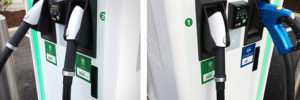By Heather Flanagan, Marketing Manager of EV Infrastructure at ABB Inc.
Charging standards are far more mature than they were a few years ago when the first production EV’s were landing in the hands of early adopters. EVs and related charging technologies have continued to evolve, keeping the whole industry on its collective toes. Yet through all this change, there are some basic vehicle interoperability principles that keep rapid change manageable – and will support EV growth at scale as we accelerate well past these early adoption curves.
1) Choose open standards
Open standards offer the entire industry a safe, highly tested
and proven connection system, regardless of power level, connection type or
form factor. They do require more collaboration
and patience, but it usually takes a bit of work to create more sustainable
success.
When barriers to entry and innovation are eradicated by
open standards, every best idea can rise to the top. Automotive oligarchies
existed for a long time, and while they created fun, amazing vehicles and state-of-the-art
manufacturing paradigms along the way, the high barrier to entry contributed to
the stifling of new players who might have innovated more and pushed
electrification faster.
Tesla, with its bold and fearless vision, invested in its
own charging protocols because it wasn’t willing to wait for the rest of the
industry to sort it out. And in its huge and well-deserved success, Tesla has provided
inspiration to scores of new and traditional vehicle makers who are clamoring
to offer the next great electric transportation solution. Yet paradoxically, as
Tesla’s genius has driven what promises to be a richly competitive market, that
market now demands open standards as a core underpinning to widespread infrastructure
investment and EV proliferation.
The end game to the open methodology an economic payoff across the board. Open standards pave the way for high utilization as more charging assets can be used by more vehicles, all the time. This is true for a public charging business models or a private fleet operation—and that economic payoff creates the strongest path for EV growth in every region and use case.
2) Patents giveth but they can also taketh away
Patents are tools of the technology trade, and intellectual property can be an important wellspring of private sector investment in R&D. But when patents threaten to stifle basic, core functionalities – such as EV connection systems and network communications – they become a wet blanket to an otherwise pioneering market. Even where patents are available to a market, they still require adherence to proprietary licensing schemes and fees that fleece a whole industry in perpetuity. But what could be most stifling to innovation under proprietary scenarios is single-company control of development and technological progress, creating a precarious state that can suppress wider market growth and adoption.
3) It’s always cheaper to test in a planned lab environment than reactively in the field
While standards provide the recipe for vehicle interoperability, how the ingredients are cooked is still subject to a bit of interpretation. Vehicle makers of every kind and models of every use case should be tested with every charging technology provider to ensure that when a vehicle launches it works with existing infrastructure sites. Sending hardware and software engineers to the field to manage surprises and customer frustrations will not increase EV adoption nor ever make financial sense.
4) Don’t look the other way
At ABB, every employee, from day one, is instilled with the
safety mantra, “Don’t Look the Other Way.” This means that safety is always
first, no matter what. Always walk the talk. Safety never takes a back seat to
the expedient interests of time or money.
Safety should be the number one goal for everyone working in
the EV industry. Faced with an increasingly disruptive force, some interests are
still trying to condemn the promise of e-mobility. The survival and prosperity
of vehicle electrification depend on trust. This means that every EV technologist
must be engaged with relevant safety and standards organizations.
Infrastructure deployers should always make choices for the safest standards-driven
equipment, secure software, well-trained installers and the most sustainability-driven
partners.
When it comes to open charging standards, safety is pre-written in the code. It doesn’t need to be re-created time and again. This assurance pays off every time a vehicle plugs in, as safety checks built into the connection protocols run back and forth between the vehicle and charger at lightning speed. This back-and-forth communication ensures safety not only inside the vehicle, but through the charging system and its connection to the grid. Within this code lies the interoperability testing and validation collaboration necessary between vehicle architects and charging technologists – and why testing and validation must take place before every new vehicle hits the road.
5) Deploy from experience
Mistakes repeated are wasted time, energy and money. Car, truck, van and bus makers ought to plan well ahead for vehicle interoperability testing and validation in their product development cycles. Every entity that funds or deploys a bus or fleet charging infrastructure project ought to require interoperability testing and validation as a part of their program. Every member of the EV industry benefits when learning from one another. Great work happens in standards groups, at conferences and within business partnerships – from physical charging connections to network roaming integrations – through these pathways, the EV industry is, and will continue to be, much greater than the sum of its parts.
Download our Vehicle Interoperability Checklist
How well do you know vehicle-side interoperability?
Take our quiz
Source: Electric Vehicles Magazine


